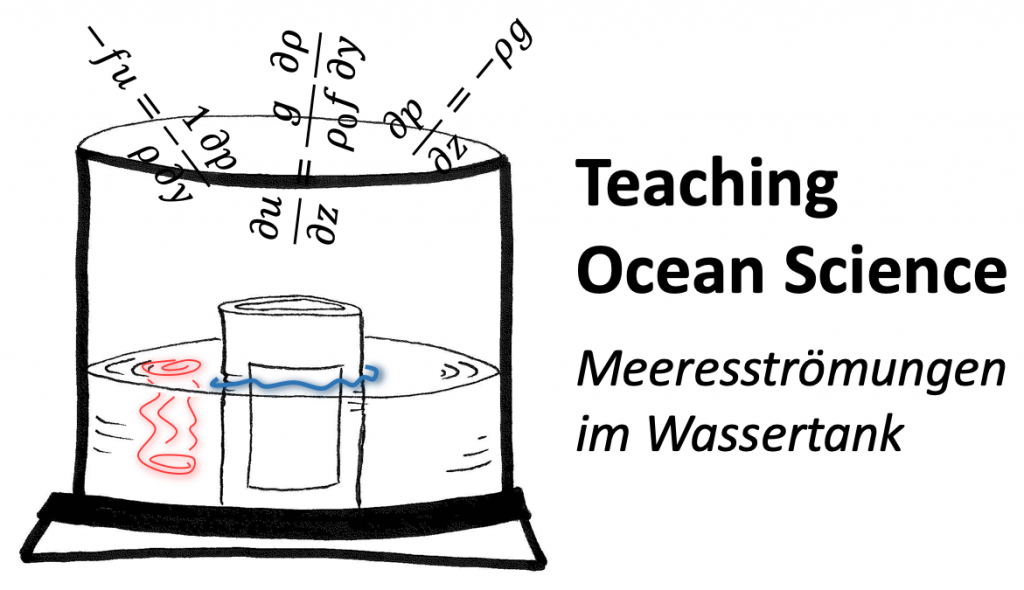oder: Man muss einfach vielmehr spielen!
After teaching atmosphere and ocean dynamics (AOD) for a couple of years I wanted to introduce something new to this course, which is part of the BSc program Physik des Erdsystems (Physics of the Earth system) at Kiel University. The course is kind of a tutorial accompanying the lecture. Typically we discuss weekly exercises, in which relationships and formulas derived in the lecture are applied to practical problems. Personally, I like visualising problems with graphs, sketches, or—considering fluid dynamics is about flow—animations or movies. Thus I thought a lot about how to include this in class that traditionally focusses on chalk and board. There are plenty of fascinating movies about fluid dynamics on the internet. But wouldn’t it be so much more fun to actually do these experiments yourself, in the seminar room?
However, the effects of Earth’s rotation naturally plays an important role in the theoretical basis of large-scale fluid dynamics. Thus I was imagining rotating tank experiments. But all rotating tanks I had seen so far where complicated wood-metal-big-motor constructions. Nothing saying “Do it yourself!” really.
An article published earlier this year in the Bulletin of the American Meteorological Society on “Affordable Rotating Fluid Demonstrations for Geoscience Education” by the the DIYnamics project inspired and encouraged me to actually tackle this idea. Mostly because they showed how simple setting up a rotating tank would be. And they use a LEGO motor to drive the turntable, that caught my eye 😉
Then I asked Mirjam, if she would be on board for a proposal to fund rotating tanks for the AOS class. I don’t know anybody else who is so enthusiastic about hands-on oceanography experiments—and happens to live almost next door. While I have some experience with hands-on experiments, Mirjam is a real expert and has worked a lot with “tanks” on ocean dynamics phenomenons both professionally and in her free time.
At Kiel University the PerLe fund for innovative teaching offers a fantastic opportunity to support such a remodelling of university classes. For AOD this means: “from dry theory to juicy reality”. Mirjam and I came up with a program that hopefully will provide both to the students, excitement for and fun with hands-on ocean and atmosphere dynamic features. We have also put some thought into how to take the tanks outside the class room, how to engage the students into public outreach.
Our PerLe project: “Ocean currents in a tank: from dry theory to juicy reality“: The class “Atmosphere and Ocean Dynamics” being part of the BSc program “Physics of the Earth system” at Kiel University offers basic knowledge of the global, large-scale dynamics of air and water, which are the basis of, for instance, weather forecasts and climate predictions. So far, the class is taught using mostly pen & paper (or chalk & board). Linking theory with observed phenomenons in the real world is less prioritised. To make the theory tangible and thus more comprehensible, we want to introduce rotating tank as well as numerical experiments. These will be conducted by the students themselves and accompanied by creating digital documentation in interactive group assignments.
Unser PerLe-Projekt “Meeresströmungen im Wassertank: von trockenen Formeln zu nasser Realität“: In der Veranstaltung „Atmosphären- und Ozeandynamik“ im Bachelorstudiengang Physik des Erdsystems wird das theoretische Grundgerüst zum Verständnis der globalen Bewegung von Luft- und Wassermassen erarbeitet, das zum Beispiel Wetter- und Klimavorhersagen ermöglicht. Bislang geschieht dies vorwiegend theoretisch auf Papier und an der Tafel. Die Verknüpfung der Theorie mit beobachtbaren Phänomenen der echten Welt kommt dabei oft zu kurz. Um die Theorie begreifbar zu machen, wollen wir praktische Experimente – in rotierenden Wassertanks und am Computer – einbetten. Diese werden von den Studierenden gemeinsam durchgeführt und durch in Gruppenarbeit iterativ erarbeitete, allgemeinverständliche, digitale Dokumentationen unterstützt.
And here we are: let’s take it for a spin!
